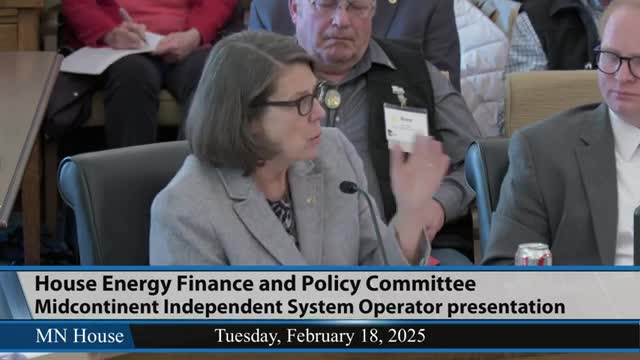MISO outlines $20 billion regional transmission plan to enhance grid reliability
February 18, 2025 | 2025 Legislature MN, Minnesota
This article was created by AI summarizing key points discussed. AI makes mistakes, so for full details and context, please refer to the video of the full meeting. Please report any errors so we can fix them. Report an error »

In a recent meeting of the House Energy Finance and Policy Committee, discussions centered around the evolving landscape of energy generation and transmission in Minnesota, particularly in relation to data centers and regional transmission planning. The atmosphere was charged with the urgency of addressing the challenges posed by the increasing demand for energy, especially as data centers look to establish operations in the state.
Mr. Tullo, a key speaker, highlighted the differences in energy market structures across regions, noting that while some areas operate under a merchant generation model, Minnesota primarily relies on a vertically integrated, rate-regulated utility system. This distinction is crucial as it influences how data centers connect to the grid and the regulatory frameworks governing them. Representative Ekom emphasized the need for further discussions on this topic, recognizing its significance for future energy planning in Minnesota.
The committee also delved into MISO's (Midcontinent Independent System Operator) ongoing efforts to enhance reliability through a framework known as the "reliability imperative." This initiative focuses on four main pillars: market redefinition, future operations, transmission evolution, and system enhancements. Each pillar aims to address the complexities of modern energy demands, including the integration of artificial intelligence and cybersecurity measures in energy management.
A significant portion of the meeting was dedicated to long-range transmission planning, a critical aspect of MISO's role as a regional transmission operator. Mr. Tullo explained that MISO is responsible for planning major transmission lines that facilitate energy movement across states, a task that individual utilities cannot manage alone. The committee learned that MISO's first portfolio of transmission projects, initiated in 2013, is only now being fully energized, illustrating the lengthy process involved in such large-scale infrastructure projects.
The discussion also touched on the financial implications of these projects. MISO recently approved a new tranche of transmission lines with an estimated cost of $20 billion, justified by a strong benefits case indicating that the economic advantages would outweigh the costs. This financial analysis is crucial as it ensures that investments in infrastructure are sound and beneficial for consumers.
As the meeting concluded, the committee members expressed a keen interest in understanding how federal funding changes might impact these initiatives, particularly in light of recent federal policies. The potential for federal grants to lower consumer costs was a point of concern, with members eager to see how these developments would unfold.
Overall, the meeting underscored the importance of strategic planning and collaboration among utilities, regulators, and policymakers to navigate the complexities of Minnesota's energy future. The discussions set the stage for ongoing dialogue about the state's energy infrastructure and its capacity to meet the demands of a rapidly changing technological landscape.
Mr. Tullo, a key speaker, highlighted the differences in energy market structures across regions, noting that while some areas operate under a merchant generation model, Minnesota primarily relies on a vertically integrated, rate-regulated utility system. This distinction is crucial as it influences how data centers connect to the grid and the regulatory frameworks governing them. Representative Ekom emphasized the need for further discussions on this topic, recognizing its significance for future energy planning in Minnesota.
The committee also delved into MISO's (Midcontinent Independent System Operator) ongoing efforts to enhance reliability through a framework known as the "reliability imperative." This initiative focuses on four main pillars: market redefinition, future operations, transmission evolution, and system enhancements. Each pillar aims to address the complexities of modern energy demands, including the integration of artificial intelligence and cybersecurity measures in energy management.
A significant portion of the meeting was dedicated to long-range transmission planning, a critical aspect of MISO's role as a regional transmission operator. Mr. Tullo explained that MISO is responsible for planning major transmission lines that facilitate energy movement across states, a task that individual utilities cannot manage alone. The committee learned that MISO's first portfolio of transmission projects, initiated in 2013, is only now being fully energized, illustrating the lengthy process involved in such large-scale infrastructure projects.
The discussion also touched on the financial implications of these projects. MISO recently approved a new tranche of transmission lines with an estimated cost of $20 billion, justified by a strong benefits case indicating that the economic advantages would outweigh the costs. This financial analysis is crucial as it ensures that investments in infrastructure are sound and beneficial for consumers.
As the meeting concluded, the committee members expressed a keen interest in understanding how federal funding changes might impact these initiatives, particularly in light of recent federal policies. The potential for federal grants to lower consumer costs was a point of concern, with members eager to see how these developments would unfold.
Overall, the meeting underscored the importance of strategic planning and collaboration among utilities, regulators, and policymakers to navigate the complexities of Minnesota's energy future. The discussions set the stage for ongoing dialogue about the state's energy infrastructure and its capacity to meet the demands of a rapidly changing technological landscape.
View full meeting
This article is based on a recent meeting—watch the full video and explore the complete transcript for deeper insights into the discussion.
View full meeting
